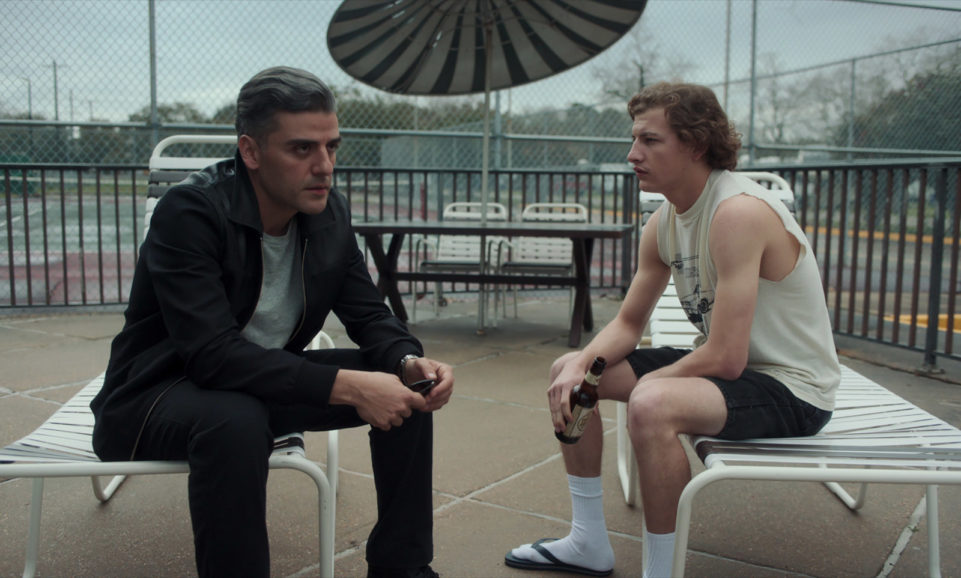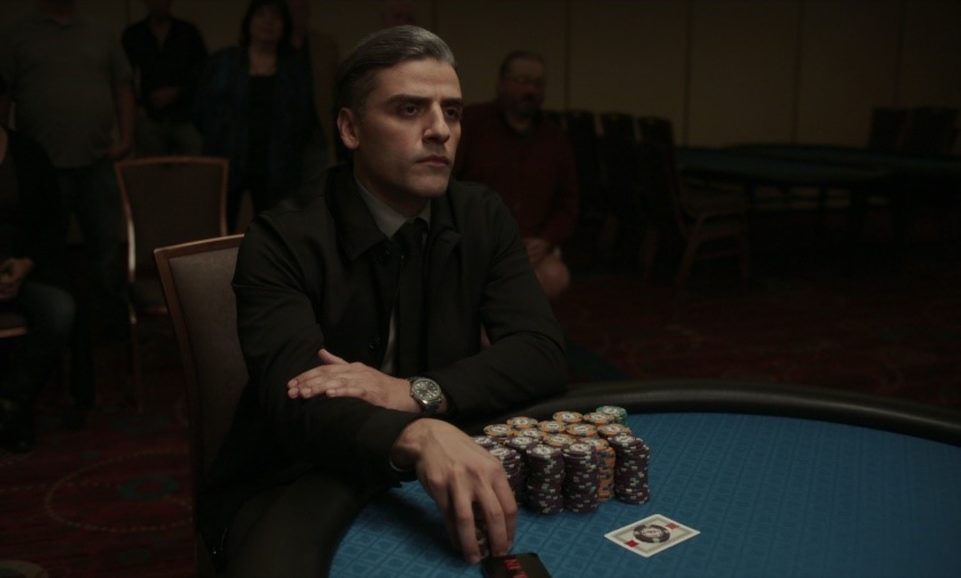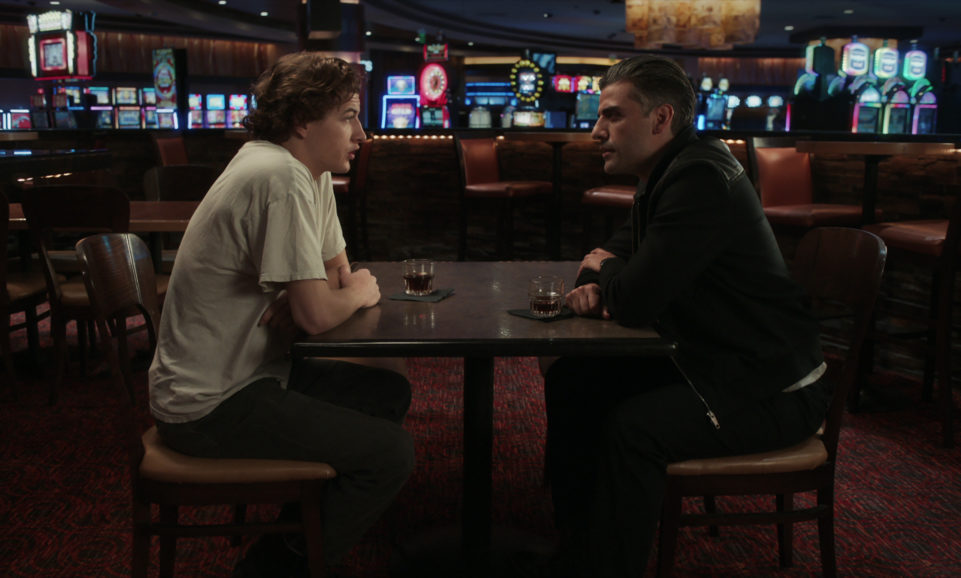TORTURED SOUL
Cinematographer Alexander Dynan reunites with writer-director Paul Schrader to explore mixing traditional cinematographic techniques with VR-inspired imagery to communicate a story of retribution and past trauma.
A narrative centred around traumatic memories and a visual language carefully crafted to convey isolation, anguish, and guilt form the foundations of revenge thriller The Card Counter. Writer-director Paul Schrader’s film marks a reunion with cinematographer Alexander Dynan, who he previously collaborated with on First Reformed (2017) and Dog Eat Dog (2016).


Master of the character study, Schrader – who penned the scripts for compelling examples of this form of filmmaking including Raging Bull and Taxi Driver – this time turns his attention to former Abu Ghraib military interrogator-turned-gambler William Tell (Oscar Isaac) who, having spent a decade in jail, seeks redemption and revenge upon his release.
Schrader – whose style has often been influenced by the work of Robert Bresson including Pickpocket (1959), A Man Escaped (1959), and Diary of a Country Priest (1951) – sought inspiration from the French filmmaker once again. When shooting First Reformed, Schrader and Dynan contemplated what Bresson might have created had he had access to digital cinematography.
“Bresson shot with very slow lenses at 50 ASA, so he didn’t have the option to shoot at a deep stop and hold multiple image planes in focus. Paul and I came up with the idea that if Bresson had the latitude of digital he might want to use the expanded focus to allow the viewer to lean in and look at different parts of the image rather than being directed towards one thing,” explains Dynan. “Paul is drawn towards telling stories about characters who have experienced past trauma, the details of which are gradually revealed throughout the film. I was excited to use some techniques from First Reformed to tackle another of Paul’s worlds and ideas about masculinity in The Card Counter’s tale of a tortured, solitary man.”

With this motivation in mind, a crisp approach was adopted, executed using ARRI’s Alexa LF and ARRI DNA LF lenses, supplied by ARRI Rental.
“We also wanted to evolve the look created in First Reformed by using the width of the medium format camera to convey Tell’s isolation and loneliness.” Dynan cropped to 1.66:1 to further “isolate Tell at the poker table but still feel the excitement of the neon-drenched backgrounds”.
Framing inspiration was derived from another of Bresson’s films, Au Hassard Balthazar (1966), which similarly crops to 1.66:1. “This often dictated our singles,” Dynan elaborates. “And if two characters are shown in the same frame they are frequently in parallel. Generally, we chose the same recurring lensing to create a resonance for the viewer, reinforcing relationships and demonstrating when characters are aligned.”

Five weeks prep were followed by three weeks of shooting before COVID paused production. While the pandemic interrupted filming, it was “incredible to return to shoot the final five days even though they were under completely new circumstances.” Luckily most of the more complex sequences featuring larger crowds in a room playing poker had been captured prior to the pause. The break in shooting also allowed Schrader to examine elements that were not working in the edit and re-evaluate some relationships between characters to benefit the narrative.
During location scouting in Biloxi, Mississippi – where the 26-day shoot took place, predominantly on location, except for the Abu Ghraib torture sequence whose sets were built on stage – Schrader commented that he felt like he was “almost floating” as they moved between the casinos. “Paul said he felt like he was existing in these non-places; being guided,” says Dynan. “That sparked the idea that Steadicam and camera movement would play a significant part in the cinematic language.”
Dynan worked in partnership with “incredible Steadicam artist” Nick Müller to capture shots of Tell meandering through the casinos, “as the audience follows and almost meditates with him”. This drifting technique influenced other sequences such as the sweeping movement over the tables at poker events.

Light shaping and VR exploration
Extensive lighting research carried out for First Reformed proved valuable when crafting the world of The Card Counter. However, as Dynan explored the casinos and saw the browns, khakis, and repetitions of colour, he realised that if he had the ability to turn many of the lights off, he could attempt to venture into the territory of Italian painter Caravaggio and tenebrism, where the character is well-lit, but everything around them falls off into darkness. In many casino locations they were unable to control every shooting scenario, but, when possible, Dylan pushed for this style of lighting.
Gaffer TJ Alston helped achieve the chosen look, working with a primarily LED package including LiteMats and ARRI SkyPanel S60s and S120s, all controlled by a tablet. “Shooting with the LF, I found I had another stop and a half of light sensitivity compared to the original SXT which was great,” adds Dynan. “We’re now at a point with camera and lighting technology where the power and softness of LED are congruent, so finally you have more control over lighting and can use it to create shape, otherwise images just look flat.”

This shape was produced with the assistance of key grip Bill Hilferty who built texture through flagging, allowing “the images to come to life”. Other members of the crew who helped to build the world within which Tell’s story plays out included 1st AC Timothée Arene and DIT Ian Edwards who was involved in discussions about exposure, colour temperature and how it aligns with what colourist Tim Masick – who has worked on all Dynan’s films – wanted to achieve in the grade.
“Tim and I work very closely from the beginning of a project,” says Dynan. “We never create LUTs, but we talk a lot about lighting tests, and where we want to go from there. I generally shoot Rec. 709 with the understanding of where I’m heading, which is largely as a result of talking to Tim.”

Production designer Ashley Fenton’s expertise and tenacity were also vital when working within the confines of a relatively limited production design budget. Fenton and Dynan explored how to control the appearance of spaces – such as selecting the paint colour or wooden panelling inside motel rooms – to create the feeling that characters were travelling between different locations. One significant location – the hotel room where Tell wraps all the furniture in white sheets – required detailed exploration of colour, texture and how the sheets would be captured on camera. “In digital cinematography, bright white is our enemy,” says Dynan. “When it becomes too blown out, there’s no rescuing it, so we talked about the type of fabric, dying it down and adding a few points of grey into the mix.”
The majority of the production design budget was allocated to the creation of the notorious Abu Ghraib prison in Iraq. “Much thought went into how to create this space we had only seen in photographs,” says Dynan. “We gave ourselves artistic licence to adopt the idea that these flashbacks were Tell’s memory, so we could design the sequences in slightly different ways.”


The technique adopted to capture the disturbing and warped flashbacks of torture, which reveal that Tell served under John Gordo (Willem Dafoe) at Abu Ghraib, was a stark contrast to the feeling of “floating” Shrader sought for the rest of the film.
In the script, Schrader outlined he wanted the flashbacks to have a VR quality. “That was real head-scratcher because we were presenting the image in a traditional format that won’t be experienced through a VR headset,” says Dynan. “I searched the internet and found videos captured using VR cameras and lenses and GoPros that were displayed in a strange, flattened and warped way.”
Inspired by these extraordinary images, Dynan revisited James Wong Howe ASC’s work on Seconds (1966) and the use of wide-angle lenses and warped sets. He then spent a month working with VR consultant Ben Schwarz to find the best solution for creating a similar effect to the videos he had seen on the internet.

“The answer we found was using a Red Helium camera with a 4.3mm lens shooting 250 degrees,” says Dynan. “This captured a fisheye shot that was then expanded using Flame 3D software. The next challenge was figuring out how to achieve this on Steadicam because the lens is so wide, it needs to be far away from the operator to prevent the arm being seen.”
Steadicam operator Müller investigated how to balance the rig. He found the best solution was to invert the way a traditional Steadicam works, so the weight was distributed at the top, with the lens and camera at the front and battery pack at the back.
“It was a strange rig, but it allowed Nick to capture those scenes beautifully. I’m especially proud of the VR work as it was the most challenging from a technical standpoint but inspired directly by the script,” says Dynan. “You couldn’t shoot the whole movie that way, but I think it’s very effective in making the experience disorientating enough to try to get into Tell’s frame of mind during the process of torture. That was one of the opportunities this film presented – exploring new ideas and techniques that served the story.”












